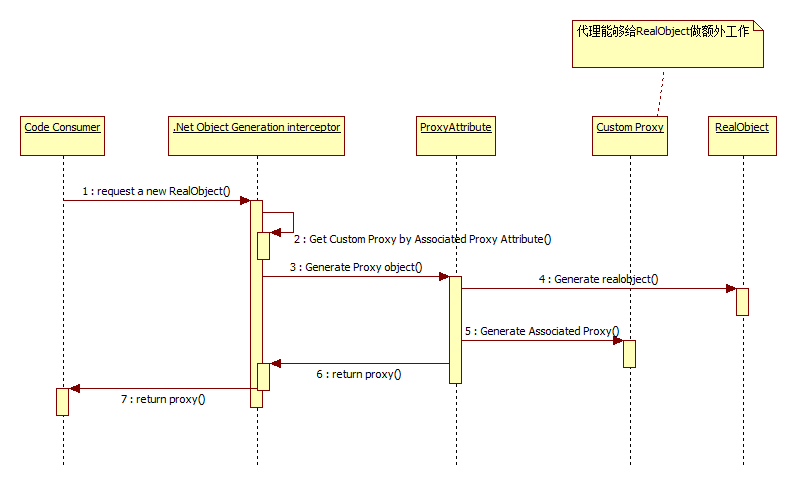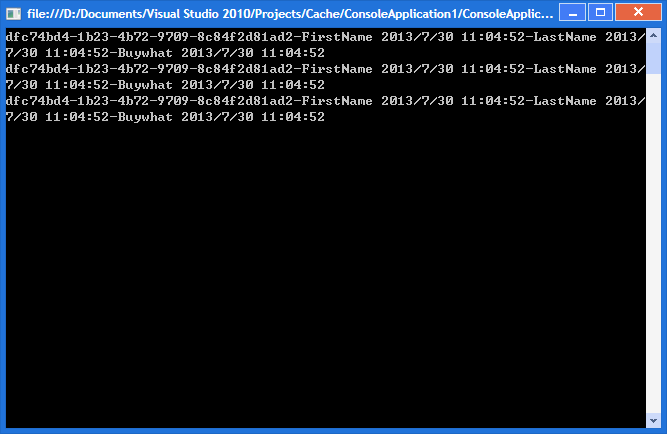放心,這次不是說設計模式中的代理模式,說的是C#的RealProxy的用法,主要用於:通過給class 貼標簽,讓class做更多的工作,比如判斷是否存在緩存,有則直接返回緩存object,沒有則保存為緩 存,等待下次請求是可以更快的獲取數據(當然這只是其中一種常用用途,MVC的Action就是采用這種 方式)
下面是序列圖:

.Net Object Generation interceptor屬於.NET自身行為,不需要額外寫代碼。
Code Consumer指想調用RealObject來進行調用的對象,比如控制台程序,或者WEB程序。
ProxyAttribute裡定義了具體代理類是哪個,這個代理類是自己 繼承RealProxy寫的一個代理類, 這個類中需要加入前置、後置、環繞等方法(具體根據需求)
下面我們來看具體如何在.Net中實現:
public class FollowAction
{
public bool StopExecute { get; set; } //用於在前置方法中,指示是否停止執行真正的方法體,比如已經找到了cache value,因此不需要繼續運行方法體的情況
public object Result { get; set; } //保存cache value的變量
}
public abstract class CachableRealProxy : RealProxy
{
private MarshalByRefObject target;
public MyAOPRealProxy(Type objType, MarshalByRefObject obj)
: base(objType)
{
target = obj;
}
public override IMessage Invoke(IMessage msg)
{
IMessage retMsg = null;
IMethodCallMessage methodCall = (IMethodCallMessage)msg;
IMethodReturnMessage methodReturn = null;
object[] copiedArgs = Array.CreateInstance(typeof(object), methodCall.Args.Length) as object[];
methodCall.Args.CopyTo(copiedArgs, 0);
if (msg is IConstructionCallMessage)
{
IConstructionCallMessage ccm = (IConstructionCallMessage)msg;
RemotingServices.GetRealProxy(target).InitializeServerObject(ccm);
ObjRef oRef = RemotingServices.Marshal(target);
RemotingServices.Unmarshal(oRef);
retMsg = EnterpriseServicesHelper.CreateConstructionReturnMessage(ccm, (MarshalByRefObject)this.GetTransparentProxy());
}
else
{
bool aopAttributeExists = false;
object[] attrs = methodCall.MethodBase.GetCustomAttributes(false);
if (attrs != null && attrs.Count() > 0)
{
foreach(object o in attrs)
{
CachableAttribute attr = o as CachableAttribute;
if (attr != null)
{
aopAttributeExists = true;
break;
}
}
}
FollowAction follow=null;
if (aopAttributeExists)
follow = this.PreProcess(msg);
try
{
object returnValue = null;
if (follow != null && follow.StopExecute)
returnValue = follow.Result;
else
returnValue = methodCall.MethodBase.Invoke(this.target, copiedArgs);
methodReturn = new ReturnMessage(returnValue, copiedArgs, copiedArgs.Length, methodCall.LogicalCallContext, methodCall);
if (follow == null || !follow.StopExecute)
if (aopAttributeExists)
this.PostProcess(msg, methodReturn);
}
catch (Exception ex)
{
if (null != ex.InnerException)
{
methodReturn = new ReturnMessage(ex.InnerException, methodCall);
}
else
{
methodReturn = new ReturnMessage(ex, methodCall);
}
}
retMsg = methodReturn;
}
return retMsg;
}
public override FollowAction PreProcess(System.Runtime.Remoting.Messaging.IMessage requestMsg) //處理前置方法
{
bool cacheDefinationTagExists = true;
CachableAttribute cacheDefine = CheckCacheDefinationTag(requestMsg, ref cacheDefinationTagExists);
if (!cacheDefinationTagExists)
return null;
string cacheKey = cacheDefine.GenerateCacheKey();
object o=CacheManager.Instance().GetCacheCore().Get(cacheDefine.Location, cacheKey);
if (o != null)
{
FollowAction follow = new FollowAction();
follow.Result = o;
follow.StopExecute = true;
return follow;
}
return null;
}
public override void PostProcess(System.Runtime.Remoting.Messaging.IMessage requestMsg, System.Runtime.Remoting.Messaging.IMessage responseMsg)//處理後置方法
{
bool cacheDefinationTagExists = true;
CachableAttribute cacheDefine = CheckCacheDefinationTag(requestMsg, ref cacheDefinationTagExists);
if (!cacheDefinationTagExists)
return;
ReturnMessage returnMsg = (ReturnMessage)responseMsg;
string cacheKey = cacheDefine.GenerateCacheKey();
CacheManager.Instance().GetCacheCore().Set(cacheDefine.Location, cacheKey, returnMsg.ReturnValue);
}
private static CachableAttribute CheckCacheDefinationTag(System.Runtime.Remoting.Messaging.IMessage requestMsg, ref bool cacheDefinationTagExists)//Help函數
{
IMethodCallMessage methodCall = (IMethodCallMessage)requestMsg;
object[] attrs = methodCall.MethodBase.GetCustomAttributes(typeof(CachableAttribute), false);
if (attrs == null || attrs.Count() <= 0)
cacheDefinationTagExists = false;
CachableAttribute cacheDefine = attrs[0] as CachableAttribute;
if (cacheDefine == null)
cacheDefinationTagExists = false;
return cacheDefine;
}
}
還需要2個Attribute: 如上代碼中用到的CachableAttribute和CachableEnabledAttribute
CachableAttribute用來貼在各個函數簽名上,可以指定cache的key等信息(繼承自普通的 Attribute)
CachableEnabledAttribute用來關聯 自定義proxy以及需要被代理的class的,用法是貼在被代理的 class簽名上(繼承自ProxyAttribute)
代碼如下:
public class CachableAttribute : Attribute
{
public string Location { get; set; }
public string Key { get; set; }
public CacheAction CacheAction { get; set; }
public string KeyPath { get; set; }
public object CacheObject { get; set; }
public TimeSpan ExpireTimeSpan { get; set; }
public DateTime AbsoluteExpireTime { get; set; }
public string GenerateCacheKey()
{
//will be changed
return string.Format("{0}", this.Key);
}
}
public class CachableEnabledAttribute : ProxyAttribute
{
public override MarshalByRefObject CreateInstance(Type serverType)
{
MarshalByRefObject target = base.CreateInstance(serverType);
CachableRealProxy rp = new CachableRealProxy(serverType, target);
MarshalByRefObject obj = (MarshalByRefObject)rp.GetTransparentProxy();
return obj;
}
}
被代理的class需要繼承自ContextBoundObject
[CachableEnabled()]
public class RealObject : ContextBoundObject
{
[Cachable(Location = "OrdersQuery", CacheAction = CacheAction.Read, Key = "OrderQueryService_QueryByFirstName_{0}")]
public override QueryResult<QueryDto.OrderDto> QueryByFirstName(string firstName, PagingInfo pgInfo)
{
QueryResult<QueryDto.OrderDto> lst = new QueryResult<QueryDto.OrderDto>();
lst.List = new List<QueryDto.OrderDto>();
lst.TotalCount = 1000;
for (int i = 0; i < 1;i++ )
{
OrderDto o = new OrderDto();
o.BuyWhat = string.Format("Buywhat {0}", DateTime.Now.ToString());
o.FirstName = string.Format("FirstName {0}", DateTime.Now.ToString());
o.LastName = string.Format("LastName {0}", DateTime.Now.ToString());
o.Email = string.Format("Email {0}", DateTime.Now.ToString());
o.OrderID = Guid.NewGuid();
lst.List.Add(o);
}
return lst;
}
}
看下控制台測試代碼:
RealObject srv1 = new RealObject();
while (true)
{
Thread.Sleep(1000); //每隔1s執行調用,看看返回的時間是否相同,相同則代表已經是cachable的了
QueryResult<OrderDto> lst = srv1.QueryByFirstName("aaron", new CoreFramework.QueryService.PagingInfo() { PageIndex = 0, PageSize = 10, OrderByColumn = "FirstName", IsAscendingSort = true });
foreach (OrderDto order in lst.List)
{
string msg = string.Format("{0}-{1}-{2}-{3}", order.OrderID, order.FirstName, order.LastName, order.BuyWhat);
Console.WriteLine(msg);
}
}
運行效果圖:

搞定。
查看本欄目